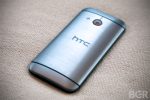Most of the excitement in the global smartphone market is found at the high end, where premium handsets packed to the gills with cutting-edge technology battle for consumers’ attention in developed markets. As we have now established, however, that’s not where smartphone sales growth is currently coming from.
Apple sells more and more iPhones each year and yet its global smartphone market share continues to sink. Why is that? Because despite how huge Apple’s iPhone sales figures are, they’re not growing anywhere near as fast as combined sales of entry-level and mid-range phones.
This is where growth is coming from and if HTC hopes to someday return to its former glory, it had better be prepared to battle in these cutthroat market segments.
At the low end, we have no idea if or when HTC plans to compete with next-generation handsets. In the mid-range though, HTC recently announced its new HTC One mini 2.
I took a quick look at the One mini 2 a couple of weeks ago and shared some initial impressions. Now, it’s time to take a closer look at this sleek new smartphone.
A natural jumping-off point might be to answer an obvious question: What’s up with this phone’s name?
Last year, HTC launched a flagship “HTC One” and a smaller, more affordable “HTC One mini.”
Pretty straightforward.
This year, HTC launched a flagship “HTC One (M8)” and a smaller, more affordable “HTC One mini 2.”
Huh?
In a meeting with HTC, a spokesperson explained that the company’s new flagship M8 is really a brand new phone. Despite having a similar shape to the original HTC One and similar software, almost everything about this great smartphone is fresh.
The One mini 2, on the other hand, is a more natural continuation of the One mini, according to HTC. This is a reasonable explanation, we suppose, considering many of the M8’s key features — Duo Camera, sensor hub, Dot View, full-fledged Zoe and so on — are not present on the One mini 2.
The phone sure looks a whole lot like the M8, though.
We’re told that HTC’s marketing will focus simply on the “HTC One” brand, so both devices are covered despite the odd naming discrepancy.
Continuing with the theme of comparing the One mini 2 to the flagship M8, the One mini 2 definitely shares the same design identity as the One (M8).
Like its flagship counterpart, the One mini 2 sports a curved back that fits very well in the hand. It feels natural to hold and the size is also nice — not too big and not too small.
The phone has a 4.5-inch 720p display that definitely doesn’t match high-end phones like the M8 and Galaxy S5, but it’s quite impressive for a mid-range device.
While the M8 features a housing that is 90% metal, the One mini 2 dials that figure back to 70%. The smaller percentage is a result of a plastic piece that surrounds the edges of the phone, joining the aluminum back to the glass face.
The phone still features a killer look that is very similar to the M8 though, and it still feels premium.
Other key physical differences between the flagship M8 and the new One mini 2 include a different speaker and sensor layout on the face of the phone, a single LED flash instead of a dual LED flash on the back, and a single camera lens rather than HTC’s two-lens Duo Camera system.
Of note, the HTC One mini 2’s rear camera is a 13-megapixel unit that takes reasonably good photos. Again, it doesn’t compare to high-end handsets, but it certainly gets the job done.
Inside, the One mini 2 looks and feels much like its high-end counterpart. For a more extensive look at the phone’s software, check out our full HTC One (M8) review.
Key differences when it comes to the phone’s software all relate to the handset’s hardware.
HTC obviously had to use less expensive components in the mini 2 in order to keep the phone’s price down. While the M8 is powered by a 2.3GHz quad-core Snapdragon 801 processor, the One mini 2 has a 1.2GHz quad-core Snapdragon 400 chipset. It also has 1GB of RAM instead of 2GB.
As a result, the HTC one mini 2 isn’t quite as responsive as the M8. It doesn’t open apps as quickly and once they’re open, operation isn’t as smooth.
I also mentioned earlier that the sensor hub from HTC’s One (M8) isn’t present in the One mini 2. This means that certain key functions from Sense 6 on the M8 — including motion launch, step tracking and Dot View case support — are not available on the mini 2.
The HTC One mini 2 lacks the M8’s full-fledged Zoe features in the camera app, as well. It will ship with the Zoe application from the Google Play store, but Zoe’s full feature set is not available.
According to HTC, the HTC One mini 2 will be priced between £360 and £370 before taxes and subsidies.
That range makes this phone much cheaper than high-end smartphones, of course, but it positions it near the top of the mid-level price range. It’s not quite as crazy as the iPhone 5c, which starts at £429 and goes up from there, but it’s still too expensive.
For an idea of what the One mini 2 is up against, here are the five best-selling mid-range smartphones right now on Amazon in the UK:
Moto G: £138 Nexus 5: £278 Galaxy S4: £310 LG G2: £285 iPhone 4S: £313
It’s a tough crowd indeed, and other markets look quite similar. The HTC One mini 2 is a gorgeous mid-range smartphone, but is it worth £80 more than a Nexus 5? Is it worth £220 more than a Moto G?
Price is the one area where HTC’s One mini 2 just isn’t mini enough.
This will be one of HTC’s biggest problems with the One mini 2, just as it has been with other recent phones. The One mini 2 is great, but is it so great that people should considering paying more for it than they would for a very popular alternative?
On-contract subsidized pricing will help level the playing field in many markets, but HTC doesn’t need to level the playing field. HTC needs to tip the scales so the odds are in its favor. It needs to undercut the competition. It needs to offer compelling features that rival phones do not. It needs to give consumers several reasons to buy its phones over the competition.
The HTC One mini 2 is a clear winner when it comes to design in the mid-range category. There is not a single widely available phone in its class that can even approach the look and feel of the One mini 2.
But is design enough?
Much less expensive smartphones are available from much more popular vendors. What’s more, Samsung owns the mid range smartphone market in many regions, and Samsung also spends billions to advertise and market its devices.
This will not be an easy fight for the One mini 2.
HTC has not announced any plans to release the HTC One mini 2 in the U.S., but it will become available in the coming weeks across Europe and Asia.


















